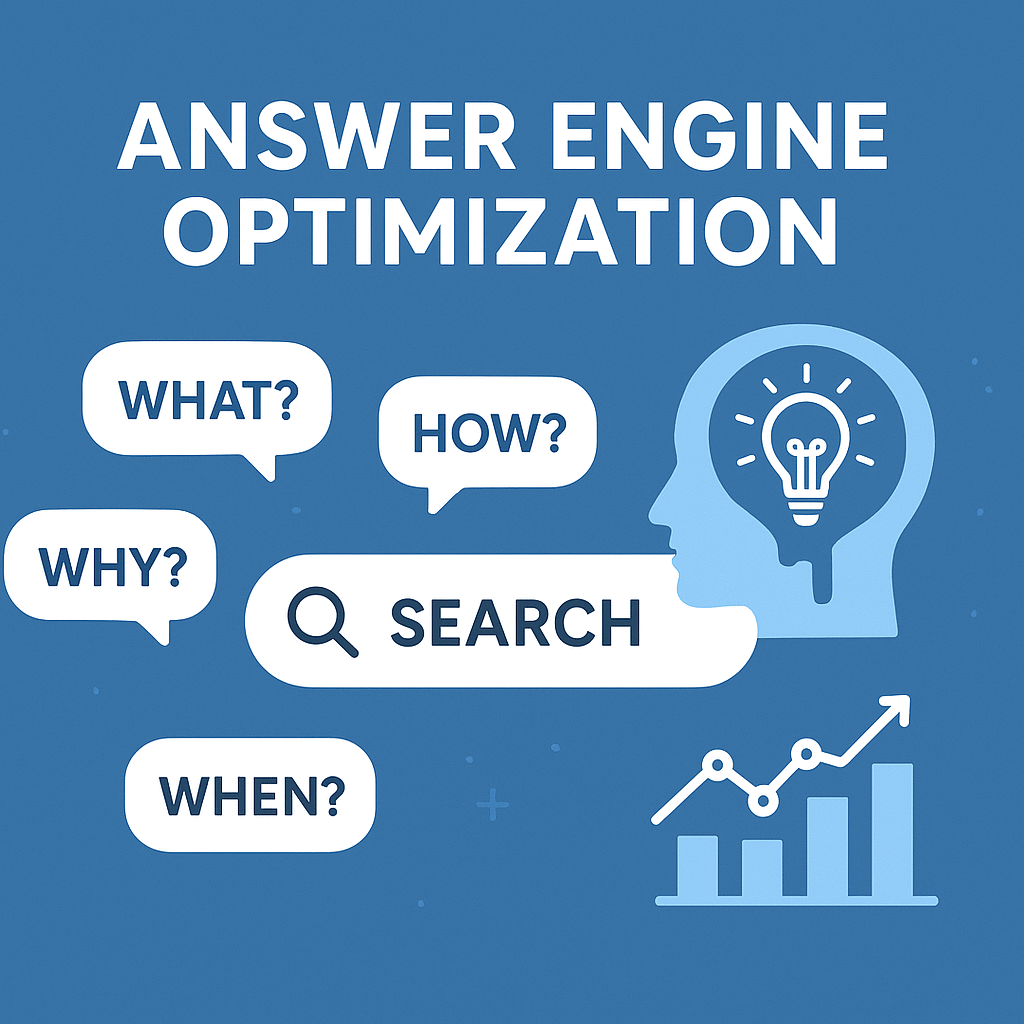
Search engine optimization (SEO) has long been the backbone of digital marketing. For decades, businesses have optimized their websites to rank higher on search engine results pages (SERPs). But as technology evolves and user behavior shifts, a new paradigm is emerging: Answer Engine Optimization (AEO). By 2025, AEO is no longer a buzzword—it’s a necessity for digital marketers, brands, and businesses that want to stay ahead in the competitive online space.
In this blog, we’ll dive deep into what AEO is, how it differs from SEO, why it has become critical in 2025, and actionable strategies businesses can adopt to optimize for answer engines.
What is Answer Engine Optimization (AEO)?
Answer Engine Optimization (AEO) is the process of optimizing digital content so that it can be directly used by answer engines—AI-driven systems like Google’s featured snippets, Bing’s AI chat, ChatGPT, Perplexity, or voice assistants such as Siri and Alexa—to provide users with concise, accurate, and contextually relevant answers to their queries.
Unlike traditional SEO, which focuses on ranking for keywords on SERPs, AEO is about creating content that:
- Directly answers user questions.
- Is structured in a way that AI systems can understand and retrieve easily.
- Provides context-rich and authoritative information that can be used as a “final answer,” not just a clickable search result.
How AEO Differs from SEO
While SEO and AEO share the same ultimate goal—getting users to find and engage with your content—they differ in how they operate:
- Focus on Answers vs. Keywords
- SEO: Optimizes around keywords and ranking factors.
- AEO: Optimizes around direct answers to specific user queries.
- Content Structure
- SEO: Emphasizes meta tags, backlinks, and on-page SEO.
- AEO: Prioritizes structured data, FAQs, conversational formats, and schema markup.
- User Intent
- SEO: Targets a mix of informational, transactional, and navigational intent.
- AEO: Primarily targets informational intent, providing immediate, reliable answers.
- Interface
- SEO: Works within traditional search engine results pages.
- AEO: Works in AI-driven platforms, voice assistants, and zero-click results.
Why AEO Matters in 2025
By 2025, digital consumption patterns have shifted dramatically. Several trends have made AEO indispensable:
1. The Rise of AI-Powered Search
AI search assistants like ChatGPT, Google’s Gemini, Microsoft Copilot, and Perplexity are redefining how people look for information. Instead of sifting through multiple links, users want a direct answer. Businesses that don’t adapt risk invisibility in this new ecosystem.
2. Growth of Voice Search
With smart devices and wearables becoming ubiquitous, voice search is at an all-time high. People now ask their devices conversational questions, and answer engines need clear, direct responses. Optimizing for AEO ensures your brand can become the go-to answer.
3. Zero-Click Searches
According to recent studies, over 60% of Google searches in 2024 ended without a click. This means users got their answers directly from the SERP or an AI-powered box. AEO allows businesses to thrive in this zero-click environment.
4. Trust and Authority
Users are more skeptical of online information in 2025 due to AI-generated misinformation. Answer engines prioritize trustworthy, authoritative, and verified sources. Brands that build credibility and optimize for AEO will be chosen as authoritative voices.
5. Competitive Advantage
As AEO is still an emerging field, early adopters in 2025 can differentiate themselves significantly. Being the top source for answers can elevate brand visibility and trust across multiple digital ecosystems.
Key Elements of Effective AEO
To succeed with AEO in 2025, businesses must understand and implement the following elements:
1. Structured Data and Schema Markup
Schema markup helps search engines and answer engines interpret content contextually. FAQ schema, HowTo schema, and Product schema make content easier to be featured as an answer.
2. Conversational Content
People interact with AI in natural language. Content must mirror this behavior by being conversational, easy to read, and answer-driven.
3. Content Depth and Clarity
Answer engines don’t just look for keywords—they look for complete, authoritative answers. Thin content doesn’t stand a chance in 2025. Brands must provide well-rounded insights.
4. Mobile and Voice Optimization
Since most queries come from mobile devices or voice assistants, content should be optimized for quick, concise answers.
5. E-A-T (Expertise, Authoritativeness, Trustworthiness)
Google’s E-A-T framework continues to play a crucial role in AEO. Verified authors, citations, and reputable backlinks reinforce authority.
6. Local Optimization
For local businesses, AEO ensures that when someone asks, “Where’s the best coffee near me?” your business appears as the definitive answer.
Strategies to Optimize for AEO in 2025
1. Create FAQ Sections
Answer engines love FAQ pages because they provide direct Q&A formats. Every business should develop FAQs tailored to customer pain points and industry-specific queries.
2. Target Long-Tail and Conversational Queries
Instead of focusing only on short-tail keywords, optimize for natural, conversational questions like “What is the best CRM for small businesses in 2025?”
3. Optimize for Featured Snippets
Format your content with bullet points, numbered lists, and concise paragraphs. This increases the likelihood of being featured as a snippet or AI-selected answer.
4. Improve Content Readability
Answer engines prefer content that’s easy to digest. Use simple language, shorter sentences, and avoid jargon unless necessary.
5. Leverage AI Tools for Optimization
Marketers in 2025 have access to AI-driven SEO tools that analyze content for AEO-readiness, identify missing schema, and suggest better question-focused structures.
6. Build Authority Through Thought Leadership
Publishing original research, data-driven insights, and expert opinions establishes authority. This increases the chances of being cited as an authoritative answer.
7. Use Multimedia Answers
Answer engines now process not just text, but also images, videos, and infographics. Offering multiple answer formats increases reach and engagement.
Real-World Examples of AEO in Action
- Healthcare Websites – When users ask, “What are the symptoms of seasonal flu in 2025?” AI pulls structured, authoritative content from verified healthcare sites.
- E-commerce – A shopper asks, “What’s the best laptop under $1,000 in 2025?” Answer engines highlight curated, structured product comparisons.
- Local Businesses – A voice search like “Best digital marketing agency near me” can return your business as the definitive answer if optimized.
- Finance – With queries like “What are the new income tax slabs in India 2025?”, AEO-optimized finance blogs appear as direct answers.
Challenges of AEO
While AEO presents opportunities, it also comes with challenges:
- Loss of Website Traffic: Since users often get answers directly, businesses may see reduced clicks.
- High Competition for Authority: Only a few sources are selected as definitive answers.
- Constant Algorithm Shifts: Answer engines evolve rapidly, requiring businesses to adapt continuously.
- Misinformation Risks: Competing against AI-generated but unreliable content requires stronger emphasis on trust signals.
Future of AEO Beyond 2025
Looking ahead, AEO is expected to evolve further:
- Integration with AR/VR search experiences, where users get immersive answers.
- More focus on multimodal content (text + visuals + audio).
- Stricter verification systems to combat misinformation.
- Hyper-personalized answers tailored to user profiles.
Businesses that invest early in AEO will secure long-term advantages in discoverability and brand trust.
Frequently Asked Questions (FAQs)
Q1. How does AEO differ from SEO?
SEO is about ranking well in search results by targeting keywords and optimizing technical factors, while AEO is about delivering precise, ready-to-use answers that AI systems and voice assistants can surface instantly.
Q2. Why is AEO so critical in 2025?
Because users now rely heavily on AI chatbots, smart assistants, and zero-click results, content must be optimized to serve as a trusted answer. Without AEO, businesses risk being invisible in these new search environments.
Q3. What steps can I take to optimize for AEO?
Focus on structured data, create clear FAQ pages, write in a conversational tone, answer common questions directly, and build authority with credible sources and expert content.
Q4. Does AEO completely replace SEO?
Not at all. AEO builds on top of SEO. SEO still drives visibility in search results, while AEO ensures your content is selected as the definitive answer within AI-driven platforms.
Q5. Which industries gain the most from AEO?
Sectors like healthcare, finance, retail, education, and local services see big benefits because users often search with direct, practical questions in these niches.
Q6. Will AEO reduce traffic to my site?
In some cases, users may get their answers without clicking. But being chosen as the authoritative answer improves brand visibility and credibility, often leading to more trust and long-term conversions.
Final Thoughts
In 2025, Answer Engine Optimization (AEO) is no longer optional—it’s fundamental. With AI-driven search, voice assistants, and zero-click answers dominating the digital space, businesses must rethink how they create and distribute content. AEO isn’t about replacing SEO; it’s about evolving with the way people search and consume information.
The brands that succeed will be the ones that:
- Provide clear, direct, and trustworthy answers.
- Embrace structured data and conversational formats.
- Position themselves as authoritative voices in their industries.
If SEO was about being found, AEO is about being the answer. And in 2025, being the answer is everything.

